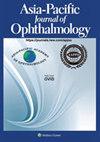法昔单抗治疗新生血管性年龄相关性黄斑变性患者的疗效、耐久性和安全性:LUCERNE中国3期亚群48周的结果
IF 4.5
3区 医学
Q1 OPHTHALMOLOGY
引用次数: 0
摘要
目的:评价法利西单抗与阿非利西贝在LUCERNE中国亚群新生血管性年龄相关性黄斑变性(nAMD)患者治疗48周后的疗效、持久性和安全性。设计:LUCERNE (NCT03823300)是一项全球3期、双盲、有效比较对照试验。中国亚群包括来自中国大陆、台湾和香港的患者。方法:Treatment-naïve年龄≥50岁的nAMD患者以1:1的比例随机分配,在四次初始Q4W剂量后,根据预先指定的疾病标准,接受法利昔单抗6.0 mg Q16W,最多每16周(Q16W),或在三次初始Q4W剂量后,接受阿非利赛普2.0 mg Q8W。主要终点是40至48周内最佳矫正视力(BCVA)相对基线的平均变化。解剖、耐久性和安全性结果也进行了评估。结果:中国亚群包括119例患者(faricimab: n = 59, afliberept: n = 60)。在第40至48周,faricimab和aflibercept的调整平均(95%置信区间[CI]) BCVA字母增益从基线分别为+9.7(7.4至12.0)和+9.8(7.5至12.1)。在第40周至第48周期间,两组患者的中心亚野厚度均较基线减少,法利昔单抗和阿非利西ept的调整后平均(95% CI)变化分别为-145.4 µm(-156.2至-134.6)和-156.5 µm(-167.3至-145.7)。到第48周,87.3%的患者延长了≥Q12W的法利西单抗剂量。Faricimab耐受性良好,无新的安全信号。结论:法瑞昔单抗在LUCERNE中国亚群中显示出持久的疗效,与全球研究结果一致。Faricimab可能在不影响疗效的情况下减轻中国nAMD患者的治疗负担。本文章由计算机程序翻译,如有差异,请以英文原文为准。
Efficacy, durability and safety of faricimab for patients with neovascular age-related macular degeneration: 48-week results from the phase 3 LUCERNE China subpopulation
Purpose
To evaluate the efficacy, durability and safety of intravitreal faricimab versus aflibercept over 48 weeks in patients with neovascular age-related macular degeneration (nAMD) from the LUCERNE China subpopulation.
Design
LUCERNE (NCT03823300) was a phase 3 global, double-masked, active comparator-controlled trial. The China subpopulation comprised patients from mainland China, Taiwan and Hong Kong.
Methods
Treatment-naïve patients aged ≥50 years with nAMD were randomized 1:1 to receive faricimab 6.0 mg up to every 16 weeks (Q16W) based on prespecified disease criteria after four initial Q4W doses or aflibercept 2.0 mg Q8W after three initial Q4W doses. The primary endpoint was mean change from baseline in best-corrected visual acuity (BCVA) averaged over weeks 40 to 48. Anatomical, durability and safety outcomes were also evaluated.
Results
The China subpopulation comprised 119 patients (faricimab: n = 59, aflibercept: n = 60). At weeks 40 to 48, adjusted mean (95% confidence interval [CI]) BCVA letter gains from baseline were +9.7 (7.4 to 12.0) and +9.8 (7.5 to 12.1) with faricimab and aflibercept, respectively. Central subfield thickness was reduced from baseline by weeks 40 to 48 in both arms, with an adjusted mean (95% CI) change of −145.4 µm (−156.2 to −134.6) and −156.5 µm (−167.3 to −145.7) for faricimab and aflibercept, respectively. By week 48, 87.3% of the patients were on extended ≥Q12W faricimab dosing. Faricimab was well tolerated with no new safety signals.
Conclusions
Faricimab up to Q16W showed durable efficacy in the LUCERNE China subpopulation, consistent with global findings. Faricimab may reduce treatment burden for patients with nAMD in China, without compromising efficacy.
求助全文
通过发布文献求助,成功后即可免费获取论文全文。
去求助
来源期刊

Asia-Pacific Journal of Ophthalmology
OPHTHALMOLOGY-
CiteScore
8.10
自引率
18.20%
发文量
197
审稿时长
6 weeks
期刊介绍:
The Asia-Pacific Journal of Ophthalmology, a bimonthly, peer-reviewed online scientific publication, is an official publication of the Asia-Pacific Academy of Ophthalmology (APAO), a supranational organization which is committed to research, training, learning, publication and knowledge and skill transfers in ophthalmology and visual sciences. The Asia-Pacific Journal of Ophthalmology welcomes review articles on currently hot topics, original, previously unpublished manuscripts describing clinical investigations, clinical observations and clinically relevant laboratory investigations, as well as .perspectives containing personal viewpoints on topics with broad interests. Editorials are published by invitation only. Case reports are generally not considered. The Asia-Pacific Journal of Ophthalmology covers 16 subspecialties and is freely circulated among individual members of the APAO’s member societies, which amounts to a potential readership of over 50,000.
 求助内容:
求助内容: 应助结果提醒方式:
应助结果提醒方式:


